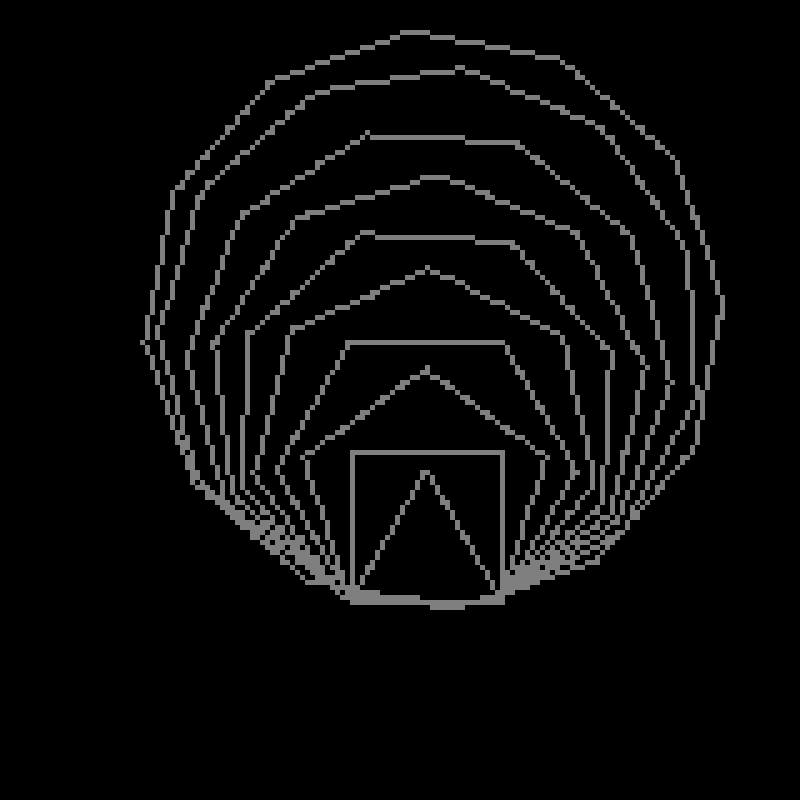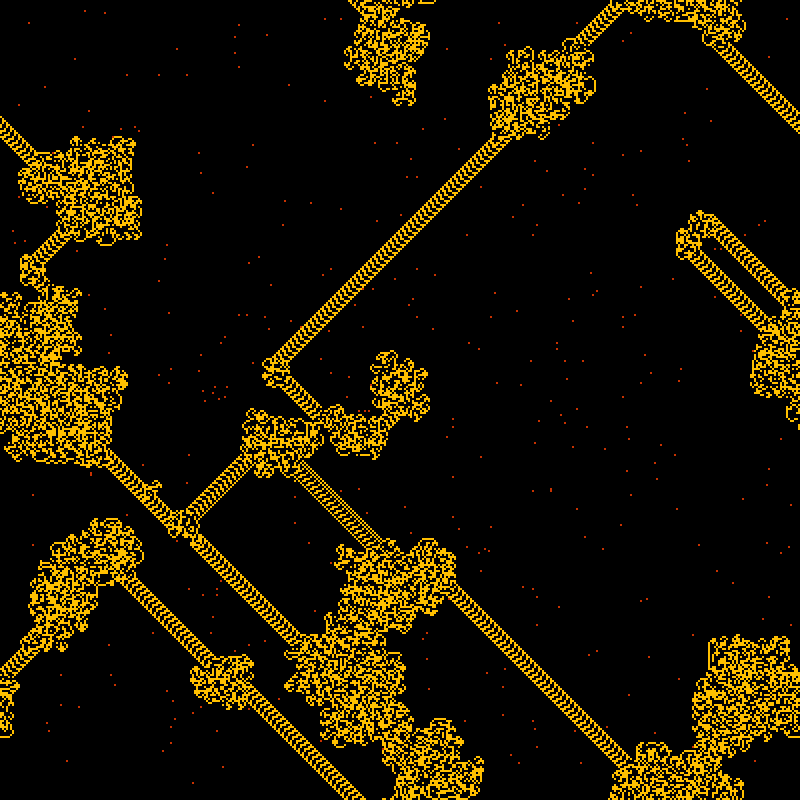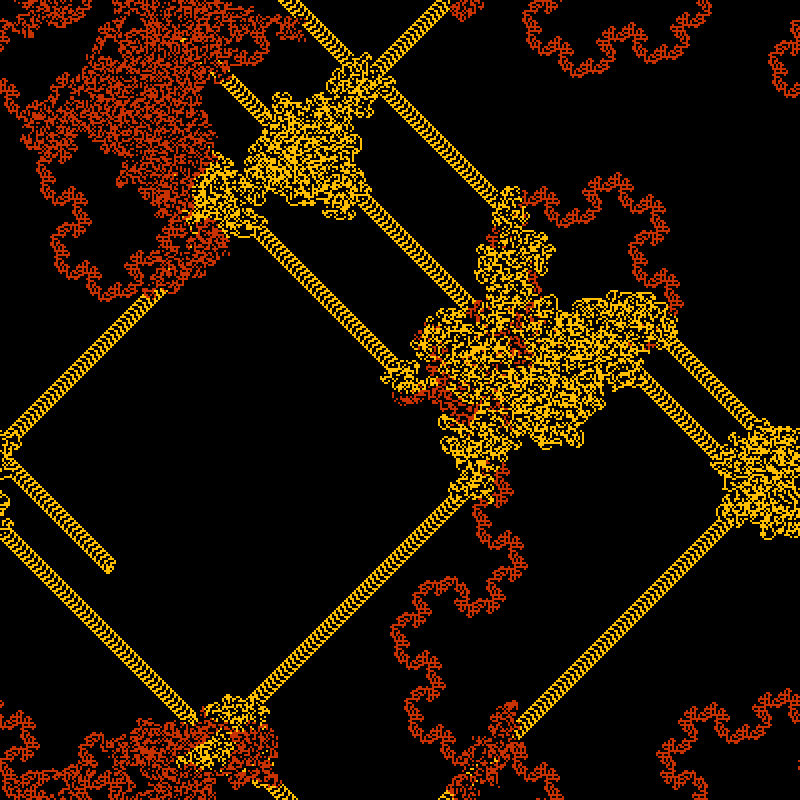antTurtle
another look at Langton’s Ant using a simple
turtle called greg
his x and y are held in a PVector and his heading is an angle
his new positon is obtained by using polar to cartesian coordinates
antTurtleNoRule shows just the basic movment of the turtle
antTurtlePoly shows the ant turtle drawing polygons using different heading angles

antTurtleRule
has Langton’s ant rules
and has the option of changes the size and setting random points
or filling the whole screen solid
which in effect creates the inverse of the ant path
AntTurtle and NetLogo vants
I compared the performance of my antTurtle with NetLogo implementation of vants.
NetLogo also uses a turtle and patches to create the visualization.
NetLogo has a zero position in the center of its grid, a classical cartesian grid. You set the size of the grid with a single number for positive and negative numbers. Thus, you always get an odd numbered grid.
In processing my grids are actually a 2d array data structure and out of habit and perhaps a preference for even things, the grid was always an even number.
However, I noticed that even the basic ant rules will produce an oscillation on NetLogo.
I then set my processing antTurtle on odd grid and was able to produce the same oscillation
Pretty interesting find!
This really highlights how important the initial conditions are to the long-term behavior of the deterministic ant function. Even the oddness or evenness of the grid has an effect on the higher order structure. (are there social or biological analogies)
I have added the NetLogo code slightly which I slightly modified from
Wilensky, U. (2005). NetLogo Vants model. http://ccl.northwestern.edu/netlogo/models/Vants. Center for Connected Learning and Computer-Based Modeling, Northwestern University, Evanston, IL
I have also added a modified processing antTurtle for comparision antTurtleNetLogoCompare
antTurtleChangeAngle
some really interesting results with rotating the antTurtle differnt degrees
left 30 right 30 makes a messy oscillation with no highway
let 60 right 60 makes an oscillation with north and south highways
left 60 right 120 makes another oscillation with diverse highways
left 1 right 1 draws circles
right 150 left 30 draws vertical and horizontal highways but right 30 left 150 doesn’t!!!
right 180 left 30 is a really tight oscillation
right 180 left 10 is a makes pretty circles and reversed does the same
right 6 left 180 is a tight oscillation
right 60 left 150 has pretty fractal loops as hightways!!!

antTurtleRndObstacleOddGrid
- odd grid makes the turtle oscillate – found this while comparing to NetLogo version
- obstacles in red will divert the antTurtle

Ant turtle 30
It is an implementation of Langton’s ant rules:
- At a blank square, turn 90° clockwise, flip the color of the square, move forward one unit
- At a colored square, turn 90° counter-clockwise, flip the color of the square, move forward one unit
but instead of 90 degrees it turns 30 degrees
there is an interesting result that it creates a deterministic oscillating macro structure that looks like an amoeba.
The oscillation is best seen if the computation is done multiple times (500 in the code) and that data is displayed after.
This increases the frequency and you can get a better feeling of its movement. ( like a time lapse video of a flowers opening, or a plant growing)
It seems to grow a heart at the upper right at about 30 frames
and a large hand seems to grow out of the bottom right at 200 frames
As this macro structure is created by deterministic rules at a lower level, this rather random looking (messy) thing will produce these structures every time you run it.
You can interact with AntTurtle30.
I have added interaction to the program.
In antTurtle30pause when you press the mouse button and drag the mouse you add color to the grid, if you hold down any key at the same time you delete color from the grid.
While you are adding or taking away color the computation of rules is paused.
When you release the button the amoeba springs to life and reacts to your interaction.
Its originally determined future is forever changed as it seems to investigate what you have done.
(in antTurtl30 I do not pause the computation. So your reaction to the grid very much reduced as the hundreds of computations are computed between each frame where you just place a single dot. This may also be a useful analogy concerning level and frequency that we face in our would!)
Questions
Is antTurtle30 alive?
Is it an analogy of life?
Is the oscillation an analogy for consciousness, self-consciousness, awareness?
Douglas Hofstadter– strange loop . Daniel Dennett etc
antTurtleClass
I have made a antTurtle class
You can initalize as many ants and set their
- x, y cooridinate
- symbol or color
- left turn angle
- right turn angle
greg = new AntTurtle(100,100,1,90,90); // (x,y,symbol,LeftturnAngle,rightTurnAngle)
mj = new AntTurtle(200,200,2,150,60);
here I have two ants following different turning rules and interacting

link to earlier work with Langton’s ant drawn without a turtle
https://github.com/greggelong/langtonsAnt